Choosing a Plant-Based Diet: Part One
 Have you ever thought about choosing a plant-based diet? There are tons of different ways to approach it, including going vegan.Vegans are a type of vegetarian who avoid all animal products and foods that come from animals such as eggs, milk, yogurt, cheese and honey. Vegans also often avoid products that contain leather, fur, silk, and wool, as well as any animal products in cosmetics and soaps (1).Health Benefits of a Vegan DietResearch from the Adventist Health Study (2) compared nutrient intake and overall health indicators of non-vegetarians, vegetarians, and vegans. Vegans had the lowest intake of total fat, saturated fat, and trans fats. These are associated with higher risk of heart disease, metabolic disease, diabetes, and certain types of cancer. Vegans also had a higher intake of vitamin C, folate, beta carotene and vitamin E, all of which nutrients that are known to reduce risk of chronic disease. Vegans were also the only group with a healthy body mass index (BMI).6 Tips for Healthful Vegan MealsVegans eat a plant-based diet that includes a variety of vegetables, fruit, grains, nuts, seeds, legumes, and oils. As in any type of healthy eating plan, choosing a wide variety of foods ensures that you will get the highest amount of nutrients. Use these 6 tips for healthy vegan meal planning:
Have you ever thought about choosing a plant-based diet? There are tons of different ways to approach it, including going vegan.Vegans are a type of vegetarian who avoid all animal products and foods that come from animals such as eggs, milk, yogurt, cheese and honey. Vegans also often avoid products that contain leather, fur, silk, and wool, as well as any animal products in cosmetics and soaps (1).Health Benefits of a Vegan DietResearch from the Adventist Health Study (2) compared nutrient intake and overall health indicators of non-vegetarians, vegetarians, and vegans. Vegans had the lowest intake of total fat, saturated fat, and trans fats. These are associated with higher risk of heart disease, metabolic disease, diabetes, and certain types of cancer. Vegans also had a higher intake of vitamin C, folate, beta carotene and vitamin E, all of which nutrients that are known to reduce risk of chronic disease. Vegans were also the only group with a healthy body mass index (BMI).6 Tips for Healthful Vegan MealsVegans eat a plant-based diet that includes a variety of vegetables, fruit, grains, nuts, seeds, legumes, and oils. As in any type of healthy eating plan, choosing a wide variety of foods ensures that you will get the highest amount of nutrients. Use these 6 tips for healthy vegan meal planning:
- Choose nutrient-packed whole grains. Try...
- Quinoa, a good source of all the amino acids we need for good health
- Amaranth, which is higher in protein than many grains and is also naturally gluten-free
- Buckwheat
- Oats and barley, which contain fiber that helps lower cholesterol levels
- Wild rice, a good source of protein, with twice the protein and fiber of brown rice (3)
- Instead of protein foods from animals (such as beef, pork, chicken, fish or eggs) enjoy plant-based protein foods such as tofu, tempeh, edamame, legumes, nuts, seeds and nut butters.
- Fill half of your plate with different colors of vegetables: red peppers or tomatoes, green broccoli or kale, orange carrots or butternut squash, yellow summer squash, white or brown potatoes and jicama, and blue or purple eggplant and onions. The different colors contain various amounts of phytochemicals that help promote good health.
- Instead of dairy products, enjoy soy or almond milk fortified with vitamin B12, calcium and Vitamin D.
- Choose fresh, dried, or canned fruit in its own juice for snacks and a sweet at the end of meals.
- Instead of butter, use oils from plants and nuts such as olive, flax, canola or walnut oils.
By Lynn Grieger, RDN, CDE, CPT, CWCReferences
- Veganism in a Nutshell. The Vegetarian Resource Group http://www.vrg.org/nutshell/vegan.htm accessed 10-15-13
- Nutrient Profiles of Vegetarian and Nonvegetarian Dietary Patterns. Rizzo NS, Jaceldo-Siegl K, Sabate J, Fraser GE. J Acad Nutr Diet. 2013 Aug 26.
- Whole Grains A to Z. Whole Grains Council. http://wholegrainscouncil.org/whole-grains-101/whole-grains-a-to-z Accessed 10-18-2013
